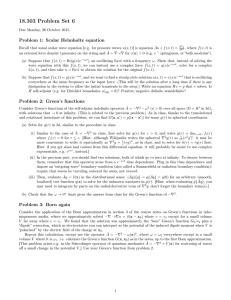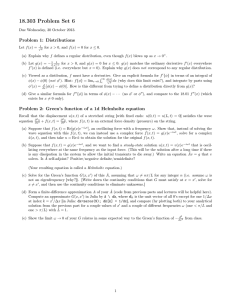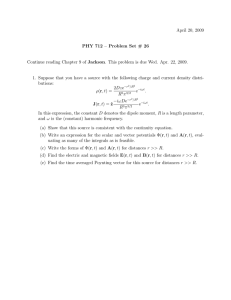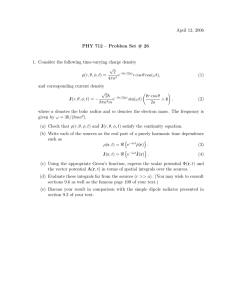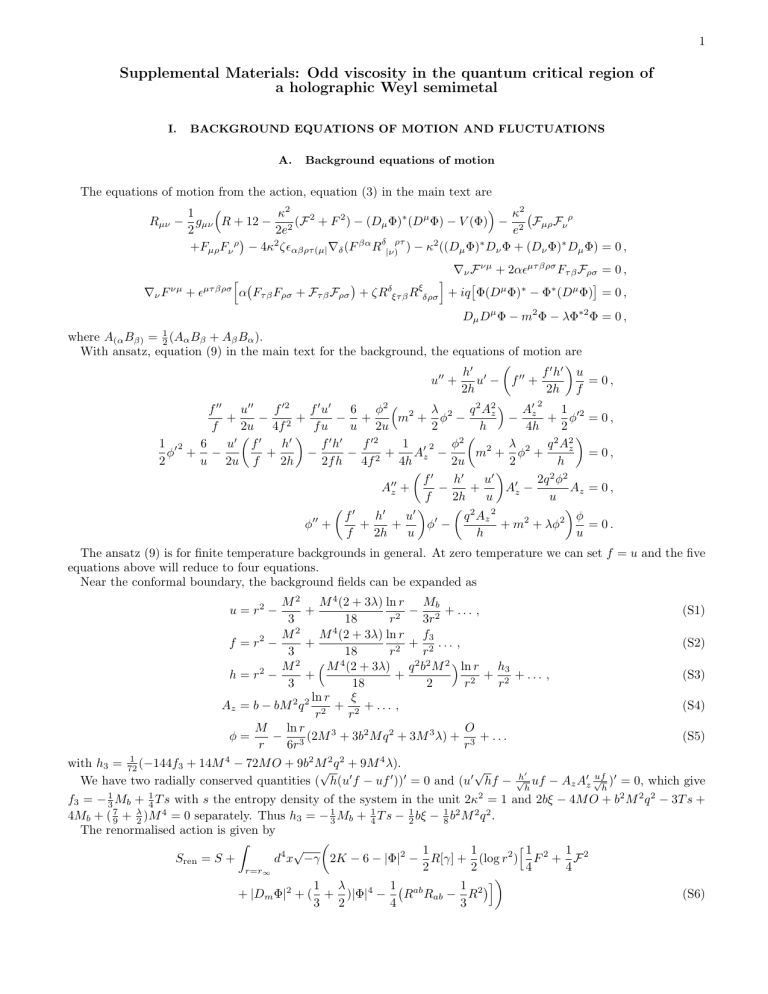
1 Supplemental Materials: Odd viscosity in the quantum critical region of a holographic Weyl semimetal I. BACKGROUND EQUATIONS OF MOTION AND FLUCTUATIONS A. Background equations of motion The equations of motion from the action, equation (3) in the main text are κ2 κ2 1 Rµν − gµν R + 12 − 2 (F 2 + F 2 ) − (Dµ Φ)∗ (Dµ Φ) − V (Φ) − 2 Fµρ Fν ρ 2 2e e ρ 2 βα δ ρτ 2 ∗ +Fµρ Fν − 4κ ζαβρτ (µ| ∇δ (F R |ν) ) − κ ((Dµ Φ) Dν Φ + (Dν Φ)∗ Dµ Φ) = 0 , h ∇ν F νµ + µτ βρσ α Fτ β Fρσ + Fτ β Fρσ + ζRδξτ β Rξδρσ i ∇ν F νµ + 2αµτ βρσ Fτ β Fρσ = 0 , + iq Φ(Dµ Φ)∗ − Φ∗ (Dµ Φ) = 0 , Dµ Dµ Φ − m2 Φ − λΦ∗2 Φ = 0 , where A(α Bβ) = 21 (Aα Bβ + Aβ Bα ). With ansatz, equation (9) in the main text for the background, the equations of motion are f 0 h0 u h0 0 u − f 00 + = 0, u00 + 2h 2h f 2 f 00 u00 f 02 6 φ2 2 λ 2 q 2 A2z A0z 1 f 0 u0 + − 2+ − + + φ02 = 0 , m + φ − − f 2u 4f fu u 2u 2 h 4h 2 1 02 6 u0 f 0 h0 f 02 1 0 2 φ2 q 2 A2z f 0 h0 λ φ + − + − 2+ Az − − m 2 + φ2 + = 0, 2 u 2u f 2h 2f h 4f 4h 2u 2 h 0 h0 u0 f 2q 2 φ2 00 − + Az = 0 , Az + A0z − f 2h u u 0 f h0 u0 q 2 Az 2 φ φ00 + + + φ0 − + m2 + λφ2 = 0. f 2h u h u The ansatz (9) is for finite temperature backgrounds in general. At zero temperature we can set f = u and the five equations above will reduce to four equations. Near the conformal boundary, the background fields can be expanded as M 4 (2 + 3λ) ln r Mb M2 + − 2 + ... , (S1) 2 3 18 r 3r M2 M 4 (2 + 3λ) ln r f3 f = r2 − + + 2 ... , (S2) 3 18 r2 r M 2 M 4 (2 + 3λ) q 2 b2 M 2 ln r h3 h = r2 − + + + 2 + ... , (S3) 3 18 2 r2 r ln r ξ Az = b − bM 2 q 2 2 + 2 + . . . , (S4) r r ln r M O − 3 (2M 3 + 3b2 M q 2 + 3M 3 λ) + 3 + . . . φ= (S5) r 6r r 1 with h3 = 72 (−144f3 + 14M 4 − 72M O + 9b2 M 2 q 2 + 9M 4 λ). √ √ 0 uf 0 We have two radially conserved quantities ( h(u0 f − uf 0 ))0 = 0 and (u0 hf − √hh uf − Az A0z √ ) = 0, which give h 1 1 2 f3 = − 3 Mb + 4 T s with s the entropy density of the system in the unit 2κ = 1 and 2bξ − 4M O + b2 M 2 q 2 − 3T s + 4Mb + ( 79 + λ2 )M 4 = 0 separately. Thus h3 = − 13 Mb + 41 T s − 12 bξ − 18 b2 M 2 q 2 . The renormalised action is given by Z h1 √ 1 1 1 Sren = S + d4 x −γ 2K − 6 − |Φ|2 − R[γ] + (log r2 ) F 2 + F 2 2 2 4 4 r=r∞ 1 λ 1 ab 1 2 i 2 4 + |Dm Φ| + ( + )|Φ| − R Rab − R (S6) 3 2 4 3 u = r2 − 2 where γab is the induced metric on the boundary, K is the extrinsic curvature and Rab [γ] is the intrinsic Ricci tensor. B. Classification of fluctuations To study the transport properties of the system, we turn on the following perturbations and study the corresponding linearized equations of motion δgµν = hµν e−iωt , δVµ = vµ e−iωt , δAµ = aµ e−iωt , δΦ = (φ1 + iφ2 )e−iωt . (S7) Since the time-reversal symmetry breaking parameter b is along the z direction, these perturbations can be classified according to their spin under the rotation symmetry group SO(2) in the xy plane as follows.1 • Spin 2: hxy , hT = 21 hxx − hyy . These two fields couple together and they are responsible for the transverse shear and odd viscosities (section III). • Spin 1: hxz , hyz , ax , ay , vx , vy , htx , hty . The equations for vx , vy couple together and decouple from other modes. The mixed anomaly term plays no role in the equations of vx , vy , thus the transverse electric conductivities are the same as in [S1]. The modes hxz , hyz , ax , ay couple with each other and they contribute to the longitudinal shear and odd viscosities (section II). The modes htx , hty couple together which are responsible for the thermal conductivity (section IV). • Spin 0: htz , hzz , hxx + hyy , at , az , vt , vz , φ1 , φ2 . The equations for vz is still the same as in [S1]. This sector will also contribute to one shear viscosity and two bulk viscosities. For our purpose of studying the odd viscosity we do not study these modes in this paper. The equations of motion for the fluctuations vx , vy and vz are the same as the case without mixed anomaly term [S1]. Given the fact that the background is also the same as in [S1], the discussions on the phase transitions and electric conductivities in [S1] still apply straightforwardly and the mixed axial gravitational anomaly does not play any role here. II. LONGITUDINAL VISCOSITY To compute the longitudinal viscosities of this system, we perturb the background solutions by (spin 1 sector) δgxz = hxz (r)e−iωt , δgyz = hyz (r)e−iωt , δAx = ax (r)e−iωt , δAy = ay (r)e−iωt . After redefining the fields 1 hxz ± ihyz , Y± = g xx hxz ± ihyz = f a± = ax ± iay , (S8) we have the following linearized equations h 2f 0 i h ω2 2ζω 2ζω 2f 0 1 ± √ C1 Y±00 + + P1 ± √ C1 + D1 Y±0 + 2 f u h h f i h i h 0 00 0 2 f f Az 2ζω S1 0 2q Az φ2 2ζω W1 i 2ζω C1 Y± + ± √ a± + ± √ a± = 0 , ± √ E1 + D1 + f f f uf h h f h f 0 2 u h0 ω 8αωA0z 2q 2 φ2 √ a00± + + a0± + ± a± − u 2h u2 u u h fh 2ζω i 2ζω f 0 S1 − A0z ± √ S1 Y±0 ± √ − + f G1 Y± = 0 , h h h h 1 We chose the radial gauge ar = vr = gµr = grµ = 0. (S9) 3 where the coefficients C1 , P1 , D1 , E1 , S1 , W1 , G1 are C1 (r) = 2A0z , h0 u0 − , P1 (r) = u 2h u0 h0 0 Az , − D1 (r) = 2A00z + 2 u h u0 f 02 f 0 h0 f 0 00 2ω 2 3f 0 u0 h0 u0 f 00 u00 0 E1 (r) = − Az + + + Az , + − + − − u f u2 f2 fh fu hu f u h02 2hf 00 hf 02 S1 (r) = 2h00 − − + 2 , h f f 03 03 02 0 2hf 2h 2hf u f 00 h0 2h02 u0 4hf 0 f 00 3hf 00 u0 f 0 h00 W1 (r) = − 3 + 2 + − − + − + 2 2 f h f u hu f f fu f 4h0 h00 3u0 h00 hu00 f 0 u00 h0 2hf 000 − + − + − + 2h000 , h u uf u f h02 2f 00 f 02 2h00 + − 2 + 2 , F1 (r) = −S1 /h = − h f f h u0 f 02 u0 h02 f 00 h0 u0 f 00 f 0 h00 u0 h00 u00 f 0 u00 h0 G1 (r) = − − − + + − + . uf 2 uh2 fh uf fh uh uf uh A. (S10) Finite temperature solutions To calculate the retarded Green’s function, we take the following redefinition for the perturbations at finite temperature and small ω/T (1) (0) (1) (0) (S11) Y± = u−iω/(4πT ) Y± + ωY± + . . . , a± = u−iω/(4πT ) a± + ωa± + . . . (0,1) (0,1) where Y± , a± in ω become are regular functions of r − r0 near the horizon. Then the equations for these fields at zeroth order (0)00 a± uf 2 0 0 uf √ Y±(0) + √ A0z a(0) = 0, ± h h u0 h0 (0)0 2q 2 φ2 (0) f A0z (0)0 + − = 0. + a a± − Y u 2h ± u h ± (S12) (S13) At first order in ω we have2 2f 0 h0 (1)0 A0z (1)0 2q 2 φ2 Az (1) 2ζ (0)0 − Y + a + a± ± √ S1 a± u f 2h ± f ± uf hf i h h 2ζ 2ζ iu0 2ζ iA0z u0 2f 0 i (0)0 (0) (0)00 ± √ W1 a± + √ C1 Y± + − ± √ D1 + C1 Y± + − 4πT f u 2πT u f hf h h h i u00 2f 0 u0 u0 h0 2ζ f0 f 00 i (0) + − + − + √ E1 + D 1 + C1 Y± = 0 , 4πT u fu 2uh f f h u0 h0 (1)0 2q 2 φ2 (1) f A0z (1)0 2ζ f S1 (0)0 h if A0z u0 (1)00 a± + + a± − a± − Y± ∓ √ Y± + u 2h u h 4πT hu h h i h 0 0 00 (0) f S1 iu 8α i u0 h0 i (0) 2ζ u (0)0 + f G1 Y± − a± + ± √ A0z − + a± = 0 . ±√ − h 2πT u 4πT u 2uh h u h (1)00 Y± + u0 + (0)0 (0) The first zeroth order equation (S12) reduces to f Y± +A0z a± = 0 under regular boundary conditions for the fields (0) (0) Y± and a± . We have two possible classes of zeroth order solutions due to two remaining integration constants after 2 The ω 2 term in E1 of (S10) should be ignored in the following equations. 4 (0) (0) imposing the infalling boundary conditions at the horizon. We focus on the zeroth order solutions Y± = 1, a± = 0, i.e. the a± modes are sourceless at leading order3 . With regular boundary condition at the horizon and sourceless (1) boundary condition at the boundary Y± can be solved to be4 (1) Y± = i ln u + 4πT Z r r0 h − √ (1) u 0 f i A0z a± f2 q 2 Az1 φ21 f12 h √ A0z dr̃ , ± 2ζ + − i √ 1 ∓ 4ζ 2 f h1 uf f u h h1 (S14) (1) where f1 , h1 , Az1 are near horizon values of f, h, Az respectively and a± is determined by (1)00 a± + u0 u + h0 (1)0 2q 2 φ2 A02 (1) f 2 q 2 Az1 φ21 f12 A0z √ a± − − z a± + i √ 1 ± 4ζ 2h u h h1 h1 uf h i 2ζ h u 0 f 2 0 2 S1 ±√ − Az − f 0 + f G1 = 0 . f uh h h (1) It follows that near the conformal boundary one specific solution of a± behaves as (1) (s0) a± = a± (s0) ln r r2 − M 2 q 2 a± (2) + a± + ··· . 2r2 (S15) (1) After adding the homogeneous solution for a± with infalling boundary condition near the horizon to the specific (1) (1) solution, one can always choose the combined solution of a± such that the source term in a± is zero. From 5 equations (S8), (S11) and (S14) we have the following solution at the conformal boundary iω q 2 Az1 φ21 f12 ω f2 (1) hxz ± ihyz = f u− 4πT 1 + ωY± + . . . = f 1 + 4 i √ 1 ± 4ζ + ... 4r h1 h1 2 4 2 2 M M (2 + 3λ) ln r 1 ω f1 q Az1 φ21 f12 √ = r2 − + + f + i ± 4ζ + ... 3 3 18 r2 r2 4 h1 h1 (S16) From this solution we can get the following conformal boundary solutions for hxz and hyz up to first order in ω hxz M 4 (2 + 3λ) ln r 1 M2 iω f12 iω q 2 Az1 φ21 f12 √ =r − + + 2 f3 + + . . . , hyz = − 2 4ζ + ..., 3 18 r2 r 4 h1 4r h1 2 where hyz is sourceless. Similarly due to the rotation symmetry in the xy plane we can also obtain the following solutions with sourceless hxz by multiplying the solutions of Y± by ±i hxz iω q 2 Az1 φ21 f12 = 2 4ζ + ... , 4r h1 hyz (0) M2 M 4 (2 + 3λ) ln r 1 iω f12 √ =r − + + 2 f3 + + ... . 3 18 r2 r 4 h1 2 (0)00 0 h0 2h (0)0 a± − 2q 2 φ2 u (0) A02 z a± h (0) 3 The second regular solution at zeroth order is a± being the solution of a± + uu + R A0 (0) (0) c − rr fz a± dr̃. By choosing suitable c we can set Y± sourceless near the boundary. 4 We have used the fact that the near horizon expansion of the background equation of motion gives us that Az2 = 2πT1 Az1 with Az2 , φ1 , Az1 the horizon values of A0z , φ and Az . Note that we have set the source term to be 1 and one can multiply the solution with an arbitrary constant to get a new solution. 0 5 − = 0 and Y± q 2 φ2 = 5 B. Holographic renormalization Near the conformal boundary, the fluctuations responsible for the longitudinal viscosities are (0) ω 2 ln r h hxz M2 2 (0) + + 2 (16M 4 + 24M 4 λ − 6M 2 ω 2 + 9ω 4 ) hxz ' h(0) xz r + hxz − 3 4 r 144 i h(2) xz 2 2 + 2 + ... , + 72a(0) x bM q 4r (0) 2 M ω 2 ln r h hyz 2 (0) hyz ' h(0) + + 2 (16M 4 + 24M 4 λ − 6M 2 ω 2 + 9ω 4 ) yz r + hyz − 3 4 r 144 i h(2) yz 2 2 + 2 + ... , + 72a(0) y bM q 4r (2) 2 ω ln r ax (0) − M 2 q2 + ax ' a(0) + + ... , x + ax 2 r2 r2 (2) ω 2 ln r ay (0) − M 2 q2 + + + ... . ay ' a(0) y + ay 2 r2 r2 Up to the quadratic order in perturbations, from equation (S6) we have the following renormalized on shell action6 Z dω 3 8 (2) (0) (2) (0) (0) Son-shell = d x a(0) x (−ω)ax (ω) + ay (−ω)ay (ω) + iαωbay (−ω)ax (ω) 2π 3 8 (0) (0) (2) (0) (2) − iαωba(0) x (−ω)ay (ω) + hxz (−ω)hxz (ω) + hyz (−ω)hyz (ω) 3 + O(ω 2 ) + contact terms , where 1 2 2 (0) (0) (0) contact terms = (−2ζ − bM 2 q 2 )a(0) x (−ω)hxz (ω) − bM q hxz (−ω)ax (ω) 2 1 (0) 2 2 (0) (0) +(−2ζ − bM 2 q 2 )a(0) y (−ω)hyz (ω) − bM q hyz (−ω)ay (ω) 2 (0) (0) (0) (0) (0) +M 2 q 2 a(0) y (−ω)ay (ω) + ax (−ω)ax (ω) + hxz (−ω)hxz (ω) 7M 4 Mb M 4λ (0) +h(0) 4f3 − + 2M O − − + O(ω 2 ). yz (−ω)hyz (ω) 12 3 2 Note that the contact terms are real and it will not contribute to the imaginary part of the retarded Green’s function. Thus if we normalize the source terms to be 1, up to the first order in ω we have Mb M 4λ 7M 4 + 2M O − − Gxz,xz = h(2) + 4f − , Gxz,yz = h(2) (S17) 3 xz yz 12 3 2 with source for hxz and sourceless condition for hyz while Mb M 4λ 7M 4 + 2M O − − , Gyz,xz = h(2) (S18) Gyz,yz = h(2) yz + 4f3 − xz 12 3 2 with source in hyz and sourceless condition for hxz . C. Results for longitudinal viscosities Thus from equations (S17), (S18) and the result we obtained in section II A we have f2 ImGxz,xz = ImGyz,yz = ω √ 1 , h1 6 ImGyz,xz = 4ωζ q 2 Az1 φ21 f12 q 2 Az φ 2 f 2 = 4ωζ h1 h . (S19) r=r0 Since we focus on the viscosities, i.e. the retarded Green’s function in the hydrodynamic limit, we only write out the result up to the leading order in the frequency. 6 Thus f2 ηk = ηxz,xz = ηyz,yz = √ h √ Using s = 4πf h r=r0 , ηHk = −ηxz,yz = ηyz,xz = 4ζ r=r0 q 2 Az φ 2 f 2 h . (S20) r=r0 , we have the shear viscosity normalized to the entropy ηk f = s 4πh r=r0 . (S21) As can be seen from Fig. S1 the shear viscosity drops significantly below the standard result of KSS bound [S2]. In view of the various results of violation of the KSS bound in anisotropic theories [S3–S6] this is not unexpected. Still it is very interesting to note that the shear viscosity reaches a minimum in the quantum critical region of M/b ≈ 0.744 as shown in Fig. S1. 1.0 0.8 4πη∥ 0.6 s 0.4 T/b=0.05 T/b=0.04 0.2 T/b=0.03 0.0 0.0 0.5 1.0 1.5 2.0 2.5 3.0 M b FIG. S1. The longitudinal shear viscosity over entropy density 4π ηk s as a function of M/b at different temperatures. Note that the Chern-Simon term of the gauge fields does not contribute to the formulae above. This indicates that only the mixed anomaly contributes to the Hall viscosity in the holographic model. III. TRANSVERSE VISCOSITY To calculate the transverse viscosities we consider the perturbations (spin 2 sector) δgxx = hxx (r)e−iωt , δgxy = hxy (r)e−iωt , δgyy = hyy (r)e−iωt on the background solutions. Define hT = 1 (hxx − hyy ) , 2 1 Z± = g xx hT ± ihxy = hT ± ihxy , f (S22) we have 4ζω 00 h 4ζω 2f 0 2f 0 i 0 1 ± √ C 2 Z± + P2 + ± √ D2 + C2 Z± f f h h h f0 f 00 4ζω f0 f 00 i + Q2 + P2 + ± √ E2 + D2 + C 2 Z± = 0 , f f f f h (S23) 7 where C2 , P2 , D2 , Q2 , E2 are C2 (r) = 2A0z , h0 f0 u0 + − , P2 (r) = u 2h f u0 f0 , D2 (r) = 2A00z + 2A0z − u f ω2 f 0 h0 f 00 u0 f 02 Q2 (r) = 2 − + + 2 − , u f 2h u f f u0 2f 02 2f 0 u0 f 0 00 2ω 2 f 00 u00 0 Az + + 2 − Az . + − − E2 (r) = − 2 u f u f fu f u A. (S24) Finite temperature solutions (0) (1) At finite temperature and small frequency we can expand Z± = u−iω/(4πT ) Z± + ωZ± + . . . , and we have7 √ (0)0 i0 uf h Z± = 0, i h u0 0 0 0 0 h f 4ζ 4ζ iu f (0)0 (1)0 (0)00 + + + ± √ D2 + 2C2 Z± ± √ C2 Z± + − Z± u 2h f 2πT u f h h h i u00 u0 h0 f 0 4ζ f0 f 00 i (0) − + + ± √ E2 + D2 + C 2 Z± = 0 . 4πT u u 2h f f f h h (1)00 Z± (0) Thus Z± = 1 and (1) Z± = i ln u + 4πT Z r h − if1 p h1 ∓ 4ζ(4πT f1 Az2 ) r0 u 0 f i 1 √ ± 4ζ √ A0z dr̃ f u h uf h (S25) with regular boundary condition at the horizon and sourceless boundary condition at the boundary, where f1 , h1 , Az2 are horizon values of f, h, A0z . Thus we have the following solution at the conformal boundary (using the relation in footnote 4) Z r h 1 p iω iω √ hT ± ihxy = f u− 4πT 1 + ln u + ω − if1 h1 ∓ 4ζ(4πT f1 Az2 ) 4πT uf h r0 u 0 f i √ A0z dr̃ + . . . ± 4ζ f u h 2 4 M M (2 + 3λ) ln r 1 ω p 2 2 if + ... = r2 − + + f + h ± 8ζq φ f A 3 1 1 1 z1 1 3 18 r2 r2 4 (S26) Similar to the longitudinal case, depending on whether we set hT or hxy to be sourceless, up to first order in ω we have hT = r2 − M2 M 4 (2 + 3λ) ln r 1 iω p iω 2 2 + + f + f h + . . . , h = − 8ζq φ f A 3 1 1 xy 1 1 z1 + . . . 3 18 r2 r2 4 4r2 or hT = 7 iω 2 2 8ζq φ f A + ... , 1 z1 1 4r2 The ω 2 term in E2 should be ignored. hxy = r2 − M2 M 4 (2 + 3λ) ln r 1 iω p + + f + f1 h1 + . . . . 3 3 18 r2 r2 4 8 B. Holographic renormalization Near the conformal boundary, the fluctuations for the transverse viscosities are (0) (0) hT ' hT r2 + hT 2 (0) hxy ' h(0) xy r + hxy (0) ω 2 hT ln r M2 + + 16M 4 + 24M 4 λ − 6M 2 ω 2 + 9ω 4 + 2 3 4 144 r (0) M2 ω 2 hxy ln r − + 16M 4 + 24M 4 λ − 6M 2 ω 2 + 9ω 4 + + 2 3 4 144 r − (2) hT + ... , 4r2 (2) hxy + ... . 4r2 Up to the quadratic order in perturbations, we have the following renormalized on shell action Z dω 3 (0) (2) (0) (2) 3 (0) Son-shell = d x hT (−ω)hT (ω) + h(0) xy (−ω)hxy (ω) − 8iαω bhT (−ω)hxy (ω) 2π (0) (0) (2) (0) (2) + 8iαω 3 bh(0) (−ω)h (ω) + h (−ω)h (ω) + h (−ω)h (ω) + contact terms , xy xz xz yz yz T where 7M 4 (0) (0) (0) contact terms = hT (−ω)hT (ω) + h(0) − 8f3 + xy (−ω)hxy (ω) 36 Mb M 2 ω2 3ω 4 − 2M O − + − . 3 8 16 (S27) Thus if we normalize the source terms to be 1, up to the first order in ω we have Gxy,xy = h(2) xy + − 8f3 + 7M 4 Mb − 2M O − , 36 3 (2) Gxy,T = hT (S28) GT,xy = h(2) xy (S29) with source in hxy and sourceless boundary condition for hT while (2) GT,T = hT + − 8f3 + 7M 4 Mb − 2M O − , 36 3 with source in hT and sourceless boundary condition for hxy . C. Results for transverse viscosities From equation (S28) and the solution found in section III A we have ImGxy,xy = ImGT,T = ωf1 p h1 , ImGxy,T = −ImGT,xy = ω8ζq 2 φ2 f Az . (S30) r=r0 Thus we have √ η⊥ = ηxy,xy = ηT,T = f h r=r0 , ηH⊥ = ηxy,T = −ηT,xy = 8ζq 2 φ2 f Az and the KSS bound is exactly obeyed for the dissipative viscosity IV. η⊥ s = , (S31) r=r0 1 4π . MORE ON THE SPIN 1 SECTOR For completion, we also study the other modes of spin 1 sector of this system which has not been studied so far. Consider fluctuations δgtx = htx e−iωt , δgty = hty e−iωt on the background solutions and they are responsible for the thermal conductivities of the dual system. Define s± = htx ± ihty , and we have the following equations 4ζω f0 1 ∓ √ A0z s0± − s± = 0 . f h (S32) 9 0 This equation reduces to s0± − ff s± = 0. The solution to this equation is s± = cf , where c is a constant. Thus the resulting thermal conductivities are κx = κy = 0 as expected since the underlying system is at zero density. [S1] [S2] [S3] [S4] [S5] [S6] K. Landsteiner, Y. Liu and Y. W. Sun, Phys. Rev. Lett. 116 (2016) 081602, [arXiv:1511.05505 [hep-th]]. P. K. Kovtun, D. T. Son and A. O. Starinets, Phys. Rev. Lett. 94 (2005) 111601, [hep-th/0405231]. A. Rebhan and D. Steineder, Phys. Rev. Lett. 108, 021601 (2012), [arXiv:1110.6825 [hep-th]]. K. A. Mamo, JHEP 1210, 070 (2012), [arXiv:1205.1797 [hep-th]]. S. Jain, N. Kundu, K. Sen, A. Sinha and S. P. Trivedi, JHEP 1501, 005 (2015), [arXiv:1406.4874 [hep-th]]. S. A. Hartnoll, D. M. Ramirez and J. E. Santos, JHEP 1603, 170 (2016), [arXiv:1601.02757 [hep-th]].
